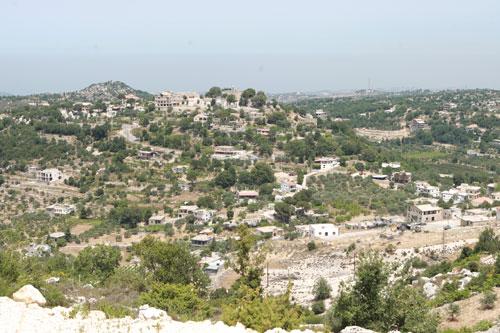Lehfed is the native mountain village of Brother Estephan Nehme. It is elevated 950 m above sea-level and limited by Jej and Mayfouk from north, Kharbe and Hakel from west and Mechmech from south. It is a beautiful summer resort in the woods of Jbeil. It enjoys a sweet climate, a generous ground rich in water and a beautiful sky. Its people and inhabitants respect morals and values. They have a great faith and piety. of Brother Estephan Nehme. It is elevated 950 m above sea-level and limited by Jej and Mayfouk from north, Kharbe and Hakel from west and Mechmech from south. It is a beautiful summer resort in the woods of Jbeil. It enjoys a sweet climate, a generous ground rich in water and a beautiful sky. Its people and inhabitants respect morals and values. They have a great faith and piety.
“Lehfed” is an Aramaic word that means “The flat land”.
Father Doueihy says in the book “Rejecting accusations”: “Lehfed was called by ancestors Kahra Hteika, a Syriac expression that refers to the Old Century. It was also called Lehfet, Hebraic word which means the Land of fear, as mentioned in the Dictionnary of Lebanese cities and villages’ names.”
In Lehfed, ruins witness the previous presence of Phoenicians, Byzantines, Syriac and Christians. These ruins prove that Maronites inhabited this village from the Middle Ages. Furthermore, history has revealed to us the names of seven monasteries and five old churches except the cells of hermits and recluses. The sons of this village had a great part in the evolution of Lebanon in general and especially of the Maronite church. There took place the revolution of Lehfed’s villagers in 1821. Two patriarchs, Youhana Lehfedy (1151-1173) and Botros Lehfedi (1173-1199) originated from this same village. During ages, this village added to the church six archbishops, we mention the Franciscan Archbishop Jebrael Eben Kalahi. Lehfed knew also holy hermits who lived in the Valley of Kadisha during the sixteenth and seventeenth centuries, the most brilliant was the her mit Youhanna Lehfedi. mit Youhanna Lehfedi.
At the end of the nineteenth century and the beginning of the twentieth century, the humble village of Lehfed was a school of morals and values and a source of monastic and priesthood vocations. Thus, it marked its inhabitants and sons with the prints of rigid piety, simplicity, satisfaction and determination. Its sons are simple, pious and humble farmers and villagers who live from their sweat and own work as well as from the goods of their generous land and fertile plains. They are joyful, happy, supportive and loving. They thank God continuously for all his gifts as well as for the land goods and the sky graces.
Everything in this village witnesses the presence of God: the high mountains, the streams, the fountains and the gentle breeze…It was among God’s eternal destination for it embraced a venerable and a saint and offered to the Almighty a distinguished blissful man. Thus, this planet appeared in the sky of the Lebanese Maronite Order; Brother Estephan belongs to his rural milieu and community before being the son of his Order. |